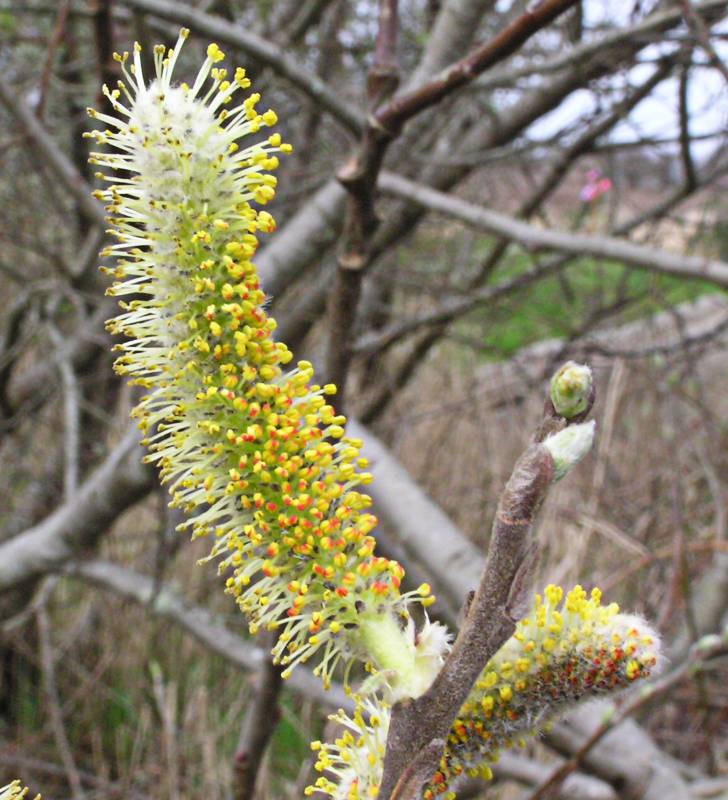Hosted by the University of Washington Herbarium, Burke Museum
Publication: Fl. Bor.-Amer. 2: 145, plate 180. 1838.
Origin: Native
Herbarium search: CPNWH
Notes: S. piperi Bebb is treated as separate species in H&C.GA recognizes the glabrous-capsuled form common in the Puget Sound region which is called S. piperi; however, he chooses to treat it as synonymous with S. hookeriana.
FNA7: "Salix hookeriana is primarily a coastal species occurring from northern California northward to Oregon, Washington, and southern Vancouver Island, with disjunct populations on Queen Charlotte Islands, British Columbia, and northward to Yakatut Bay, Turnagain Arm, and Kodiak, Alaska. It was treated by G. W. Argus (1973) and R. D. Dorn (2000) in a broad sense because of an absence of strong distinguishing characters and intergradation in characters that could be used to divide it. It is highly variable and three very similar taxa have been named: S. amplifolia, S. hookeriana (including vars. tomentosa and laurifolia), and S. piperi. Although extremes of these taxa sometimes are recognizable, the intergradation displayed is so great that even attempts to recognize them as varieties are thwarted. The amplifolia variant in Alaska is characterized by having only white leaf hairs, hairy ovaries, no stipules, and catkins often borne on distinct flowering branchlets, but variation can occur within the same population, and typical S. hookeriana on Vancouver Island sometimes displays the same characteristics. The piperi variant, an inland population in western Oregon and Washington, is usually recognized by local botanists as different from coastal populations. It is characterized by leaves and branchlets soon becoming glabrate and stipules prominent. These characteristics, however, sometimes appear in northern California coastal populations, and some inland populations in Oregon include very hairy individuals that are indistinguishable from coastal variants of S. hookeriana. In general, very hairy populations of S. hookeriana are probably an adaptation to marine coastal environments, but some variation may be due to hybridization and introgression with S. scouleriana. Inland populations suggest the influence of S. lasiolepis. Two hexaploid chromosome numbers reported for S. hookeriana from Vancouver Island (R. L. Taylor and S. Taylor 1977) and Queen Charlotte Islands (R. L. Taylor and G. A. Mulligan 1968), British Columbia, indicate that hybridization has played a role in the evolution of this complex. It is possible that each variant of S. hookeriana has had a different, possibly even recurrent, polyploid origin. Further cytological and genetic study is indicated.
The following comparisons may help to distinguish Salix hookeriana, S. lasiolepis, and S. scouleriana.
Vegetative specimens of Salix hookeriana can be distinguished from S. lasiolepis by having floral buds ellipsoid, beaks distinctly long-tapered, densely long-hairy (villous), red-brown, blades usually pilose, villous, or woolly on abaxial surfaces, usually 18-63 mm wide, and 1.5-4.2 times as long as wide; S. lasiolepis has floral buds ovoid, beaks inconspicuous and blunt, sparsely to moderately densely short-hairy (velvety), yellowish to red-brown, blades usually tomentose on abaxial surfaces, usually 6-32 mm wide, and 3.2-9.6 times as long as wide.
Salix hookeriana is distinguished from S. scouleriana by having branchlets with spreading hairs (woolly or tomentose to glabrate), petioles usually pilose to tomentose, blades typically narrowly elliptic but variable, stigmas 0.3-0.74, short in relation to styles (0.6-2.3 mm), and pistillate nectaries 0.5-1.4 mm, shorter or longer than stipes; S. scouleriana has branchlets usually with short, erect hairs (velutinous), sometimes spreading (villous or tomentose), petioles velvety or villous adaxially, blades typically oblanceolate but variable, stigmas 0.4-1.04 mm, long in relation to styles (0.2-0.6 mm), and pistillate nectaries 0.2-0.8 mm, shorter than stipes.
Hybrids:
Salix hookeriana forms natural hybrids with S. barclayi and S. scouleriana. Variation in some S. hookeriana populations suggests hybridization with S. lasiolepis but no positive identifications have been made. R. D. Dorn (2000) doubted that hybridization in California between these species with different chromosome numbers was possible, but species with different chromosome numbers do hybridize [for example, S. athabascensis (4x) × S. pedicellaris (2x)]; synthetic hybridization studies are indicated.
Salix hookeriana × S. scouleriana: Plants from southern British Columbia with leaves similar to S. hookeriana but with prominent stipules, catkins both erect and recurving, and relatively long stigmas were thought by J. K. Henry (1915) to be this hybrid."
Last updated 2/10/2024 by David Giblin.

